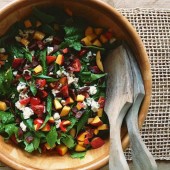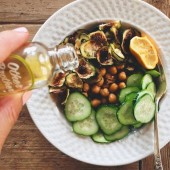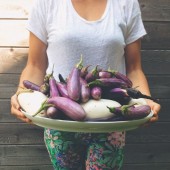We’ve done it again! Against all odds, we decided to sign up for another year of CSA adventures, this year with Bialas Farms, which operates a farm in the black dirt region of the Hudson Valley.
Although it’s not our first year with a CSA, things will be different this Summer, given that I’m a) not pregnant and b) lucky enough to have more space to prep and store each week’s haul. We have (pinching myself) a brand new beverage fridge that we’ve installed in the basement, so taking the beer out of the crisper and the wine out of the top shelves has given us a few acres of storage space for vegetables.
My plan is to document each week’s box and some of the meals cooked from the produce received, at the very least in short form. If you want more details about what I did to prep or cook one of the dishes, just leave a comment on the post. This week’s post will likely be more detailed than the ones to come, since many of the recipes will be riffs on what I’ve done this week. That’s what I’m telling myself anyway. I know that once I start to get new vegetables, my brain will be spinning with new ideas which I’ll want to put to paper. If you see me doing this kind of detailed post every week, yell at me to get out from behind the computer and go enjoy my summer for crying out loud.
My first box was highly anticipated – by me, and potentially my kids, who have been listening to me yammer on about the damn box for weeks. And it was great to finally meet Kasha, the woman, the myth, the legend behind Bialas Farms, who grow some of the best produce in the region. Kasha also writes the blog The FarmGirl Cooks, and at my first pickup, gave me some recipe inspiration, which I’ll share with you below.
So let’s get on with it, here is the Bialas Farms CSA farm share, week 1:
- Garlic scapes
- Red leaf lettuce
- Yukon gold potatoes
- Tuscan kale
- Green leaf lettuce
- Red radishes
- Bok choi
- Sugar snap peas
- Rainbow chard
- Red beets and beet greens
As you may know by now, one of the kitchen strategies that I stick to without fail is my veg prep when I get home from the market. So my heart was palpitating ever so slightly when I was faced with the mountain of greens that I’d have to wash and bag. But the work moved quickly, and within the hour, I had all of my greens prepped, labeled and stored in the fridge.
But it really does save time in the long run, and keeps your greens fresh throughout the week until you can pick up your next box, so in my book, it’s worth the extra effort up front.
Now for the fun part. I couldn’t wait for my first dinner with my new veg, but first, it was snack time. I scrubbed and trimmed the bunch of radishes, and scooped some sour cream into a bowl – the perfect vehicle for the new finishing salts I picked up in Chelsea Market last week.
Even the kids loved the treat, with the super smoky Alderwood smoked salt as the runaway favorite. Their assessment of truffle salt: “disgusting”. They’ll learn the error of their ways…
And here is where our first dinner with our CSA box went off the rails – one beer led to another, next thing we knew it was time to watch the sunset with a bottle of rose in hand. Prepping dinner took a backseat, and it was 8:30PM cheese quesadillas for everyone, followed by smores. Not a green in sight. Bialas, we apologize.
But we made it up the next morning when I fried up some eggs and locally-made pork sausage patties for breakfast, and served it alongside a heaping pile of lightly-dressed kale.
To make kale salad: In a large bowl, whisk a tablespoon of Dijon mustard with a tablespoon of white wine vinegar and a splash of lemon juice. While whisking, add ¼ cup of extra virgin olive oil, and season with salt & pepper. Tear a few handfuls of kale greens right over the dressing, and toss to combine. Let the salad marinate for 30 mins to an hour before serving, tossing every so often, to let the kale soften and absorb the vinaigrette.
One of the best things about kale salad is that it can sit in the fridge overnight, in its dressing. Perfect for tucking under poached eggs on toasted Portuguese muffins.
As I mentioned earlier, Kasha gave me some fab recipe tips, one of which was how to work with garlic scapes. They make great pesto, as long as you give them a quick blanch first. You can make it with raw scapes, but unless you’re planning on murdering some vampires, I’d suggest that you tone down the intensity a little. You can make the pesto dairy free as well – even without added parmesan, the pesto turns out almost creamy and light in color. You could leave it light, or do as I did, which was to throw in a handful of Swiss chard greens to make it a deeper green.
As with all pestos I’m making these days, this version was nut-free, and used pumpkin seeds instead of the usual pine nuts. And Lauren has thankfully jumped on the pesto bandwagon, which makes all of my previous (rejected) nut free pestos worth it. Emma loved this version too, calling it Mock ‘n moly and dipping her tortilla chips into it. She didn’t seem discouraged when I hinted that it’s not actually made with avocados, but rather garlic and leaves. Maybe our mystery food challenge is working…
To make garlic scape and chard pesto: Bring a big pot of salted water to boil and blanch 6-7 garlic scapes for 45 seconds. Drain and run the scapes under cold water to seal the color. In a food processor, pulse a handful of pumpkin seeds, and then add your garlic scapes, 2 handfuls of chard, and 2 Tablespoons of olive oil. Pulse until chopped. With the motor running, add in a few more Tablespoons of olive oil, just until you hear the pesto sloshing about loosely in the bowl. Season to taste with salt and pepper.
Note: I usually add parmesan to my pesto, but had run out, but surprisingly, the scapes make the pesto creamy enough that the cheese isn’t missed, making this perfect as a raw or vegan option.
I love to get creative with pesto, so you can imagine how happy I’ve been to have a batch of this garlic scape version in the fridge. Delicious in an update on your usual caprese by layering the pesto with fresh tomatoes and burrata cheese on grilled bread.
One of my favorite CSA vegetables to work with is rainbow chard. You can use it in endless recipes – I’ve made more chard-based vegetarian lasagnas than I can count. But don’t throw out the beautiful stems. You can sautee them along with onions as the base for any type of gratin, or you can preserve their color with a quick pickle. I can picture my next cocktail having a vibrant pickled stem peeking out of the top, or chop them and throw them into grain salads. Scatter them on top of something white or light-colored, like ricotta or burrata to make the pop of color even more visible.
To make pickled chard stems: Create your pickling liquid by boiling a saucepan full of a 2:1:1 ratio of the following: cider vinegar, sugar, and water + a pinch of salt. Arrange your stems vertically in a glass jar, and then scatter some seasonings over the top (I picked pink peppercorns and coriander seeds). Once your pickling liquid is boiling, pour it over the stems and seasonings, and let it cool, before you put on a lid and refrigerate.
Sometimes with a CSA you’re left with odds and ends from various dishes, and if you know me by now, you’ll know that I hate to throw anything away. After roasting my beets, I was left with the greens. I also had a bunch of chard and stems left over from the pesto & stem pickling.
Aside from vegetarian lasagna, gratins are a perfect vehicle for all of your leftover greens and stems. In my opinion, anything pairs well with a cheesy sauce.
Is it healthy? Not usually, but I prefer not to eat a healthy gratin. And it’s not like you’re eating the whole dish anyway, so indulge a little.
The gratin I made this week was inspired by the beautiful “Bright Lights Chard Gratin” in Deborah Madison’s “Local Flavors”. It’s a book that I bought years ago when I first moved to Berkeley, and it’s still one of my favorites. We ate every last crusty bit of this gratin, both on its own, and then two nights later on toasted Portuguese rolls with fried eggs.
To make chard and beet green gratin: In a Dutch oven on med heat, sautee a diced onion with a cup of diced chard stems in some olive oil with a pinch of salt. Add enough greens to fill the pot (I used a mix of beet greens and chard). Cover and let the greens wilt while you make the béchamel. In a separate saucepan on med heat, melt 2 tablespoons of butter; when melted, add 2 tablespoons of flour and cook for minute until it’s formed a paste. Add 2 cups of milk, slowly, avoiding any lumps. Bring to a simmer, and then cook for 5 minutes until thickened- you should be able to trace your finger down the back of a wooden spoon. Season with salt and pepper, and mix into the dish with the greens. Crumble a cup of goat cheese into the greens and mix; transfer to a baking dish and top with buttered, seasoned panko breadcrumbs. Bake at 400degrees F for 25 minutes.
Beets are an easy vegetable to prep, so long as you handle them ahead of time. Along with washing the greens, one of the first things I do when I’ve picked up my CSA box is roast the beets. And they make great impromptu salads, like this one with burrata cheese, pickled chard stems, hazelnut oil, and sherry vinegar. In fact, I think I won Emma over to the land of beet lovers with this dish; impressed with the bright red color, she sat down with me, fork in hand, and we shared it together lovingly until she nearly gagged on the texture of the burrata. You can’t win them all. Watching my 2-year old eat a plate of beets was in line with winning the lottery; burrata’s time in the sun will come….
To make the beets: Trim the leaves from the beets, and wash and scrub them. Place each beet in an individual piece of foil, drizzle a little oil and sprinkle with salt, and then wrap the foil to cover. Place on a sheet pan and roast in a 400 degree oven for an hour (beets are cooked when you can pierce them easily with a knife). Let the beets cool (I often leave them like this for a day or two), and when ready to use, slip the skins off.
I won’t claim to have done anything spectacular with my lettuce this week. Although I ate quite a few salads, they were nothing more than lettuce dressed with good olive oil, a squeeze of lemon or a little vinegar, and Maldon salt flakes. Plus the kids ate their way through the bag of green leaf lettuce, one of their favorite vegetables from our mystery food challenge.
But I do admit to having been a little confounded by the Bok Choy. Although I’ve cooked baby bok choy on occasion, I haven’t often come into contact with the grown up variety, and wasn’t sure how to treat it. Kasha mentioned that it’s wonderful on the grill, so for the second time this week, I smoked out the entire floor of my apartment building to make this dish: grilled teriyaki beef and bok choi with garlic scapes. I put everything on the grill, bok choy included, which resulted in the most beautiful smoky flavor. If I’m going to be totally honest, I used Soy Vay All-Natural bottled Teriyaki sauce to finish the dish. I usually like to make sauces myself, but it was late on Friday night, my glass of wine was waiting, and I was eager to put a nail in the coffin of my CSA box before I picked up box 2 the next day. I won’t tell you the expiration date on the bottle – it was unopened and dug out from the depths of the pantry but I’m still alive to tell you the tale. And isn’t that what a pantry is for? Bok choy emergencies?
To make the Beef & Bok Choy: On medium/high heat, grill 1 strip steak (a few pounds), 2 heads of bok choy (leaves torn off from the body so that each leaf gets some charring), and 3-4 garlic scapes. Season all with salt & pepper as it comes off the grill. This will take a few rounds of grilling if you’re using an indoor grill pan, but if using an outdoor grill, it should all fit at once. While the steak is resting, slice your bok choy and garlic scapes into chunks and add to a large bowl. Slice the steak against grain and toss with the bok choy and scapes. Add 1/4 cup of teriyaki marinade and toss to coat. Top with black and white sesame seeds and (optional but delicious) some fresh mint.
So that’s it for this week, hope you’ve gotten some inspiration for what to do with your CSA box this week. Especially those confusing scapes. Once you get the hang of using them, you’ll fall in love. Enjoy!



















I looove this! Especially all the burrata…which I continue to offer to my three year old on a regular basis, in the hope that she will one day realize it is the best food on earth.
Awesome photos too!
Yes, one day our kids will look back and kiss the ground at our feet for introducing them to things like burrata and truffle salt. Until then, it’s all ours
Looks like lots of fun and tasty outcomes! Enjoy
Thanks ML, week 2 of the CSA done! Will post tomorrow- tonight will be a stretch since we hosted all weekend. Hope it was a great one for you too
That’s way the bestset answer so far!
Love the photos, they all look great!!
Thanks Gaby, we’ve been having fun with our CSA. So much so that I’m getting behind in responding to blog comments since I’m always in the kitchen. Beautiful pics on your Instagram too
Great blog. Would love to keep seeing this for every week of the csa. I’m finding myself overwhelmed by new vegetables that I’ve never used before
Thanks so much Liz, that’s the plan. I’m about to post Week 2 so my hope is to keep it up. Enjoy the CSA!
Great blog. Would love to keep seeing this for every week of the csa. I’m finding myself overwhelmed by new vegetables that I’ve never used before so the pictures and recipes are great.
I live near your CSA farm! We love the black dirt
Fantastic! The black dirt is the best